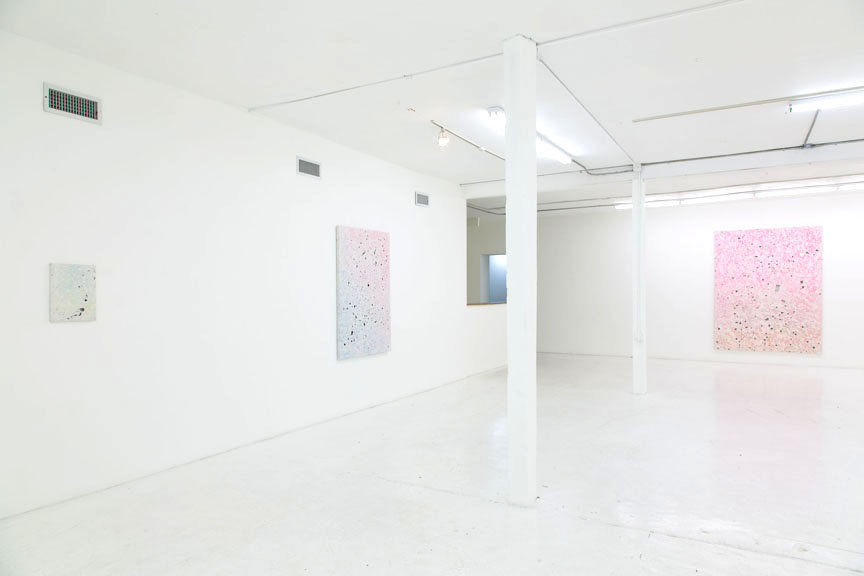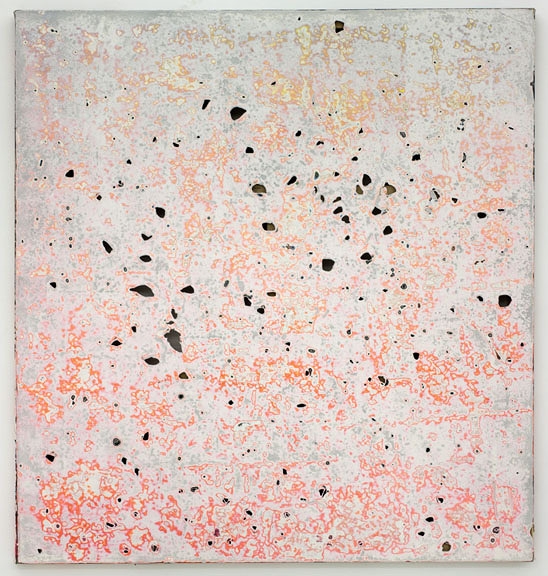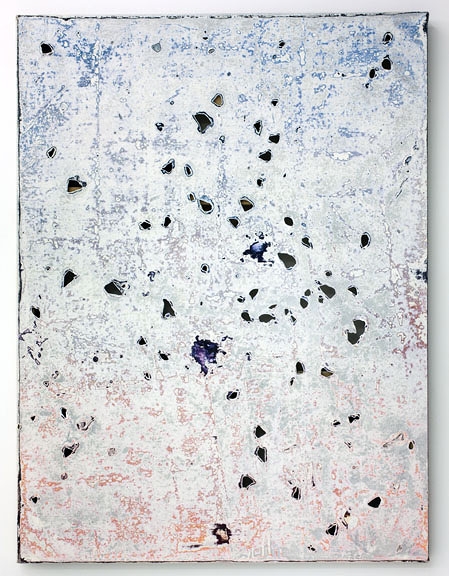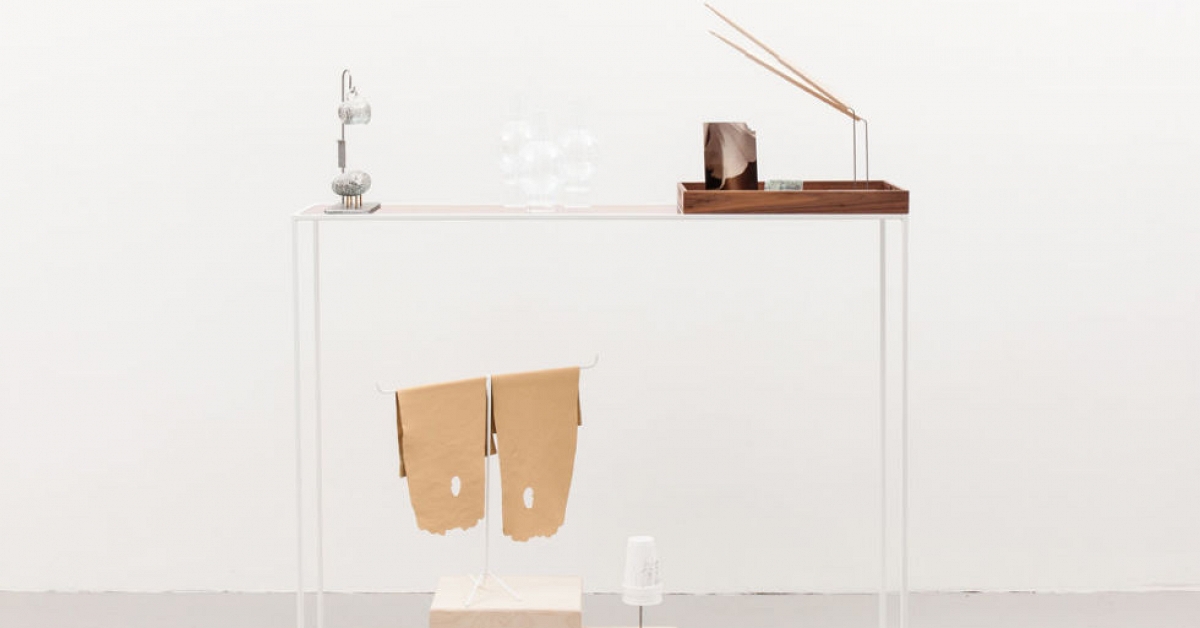Kadar Brock Studio Visit: Hunted Projects
HUNTED PROJECTS | In Dialogue New York / Sep 4, 2013 / by Steven Cox / Go to Original

As part of HUNTED PROJECTS | In Dialogue New York, it is a pleasure to present this interview and studio visit with Brooklyn based artist Kadar Brock.
Kadar Brock’s paintings are full of holes; they are sanded and worn out. To a point, Brock’s surfaces even seem to have been acid washed, gradually eroded or perhaps fiercely sand blasted, though simultaneously shredded as if struck by an explosion of shrapnel. The surfaces also are incredibly smooth, as if coated with talcum powder, though I am amongst the lucky few who have touched the surfaces of Brock’s paintings.
What’s fascinating is that Brock’s works are the product of an artist who aims to demystify the gesture in painting through creating rituals that in effect eradicate the didactic artist-viewer scenario. Brock doesn’t aim to create works that are easily read as being a by-product of an artist’s expression; Brock has created a set of rituals, a rolling of dice, where he, in effect has his actions directed for him. This could be through the number of brush strokes to apply or the number of cuts to make, in all, his intuitive approach to painting is not present or discernible to the viewer.
A video of HUNTED PROJECTS studio visit with Kadar Brock can be viewed here.
Steven Cox: I first encountered your work online long before we met earlier this year at Volta. I had been familiar with your work purely on a digital level, though upon experiencing the scale, surface qualities and vibrancy of colours, I felt that your works owned a mystical aspect that doesn’t translate via digital images. I am interested; to what extent are you conscious of this? Do you feel that something is lost when your work is presented through images online?
Kadar Brock: yeah of course. I think they’re really tactile, physical paintings, and a lot of that information is lost if you’re just looking at a reproduction.

SC: Your ritual-as-process approach to mark making is conducted through the gauze of being either dis-enchant, or re-enchantment based. Both processes refer to the removal or application of paint. I am interested in how you decide where and when the ritual takes over from the intuitive aspect of painting?
KB: So the rituals really started as an extension of, and as a way to manifest, my desire to divest intuition from painting, as a way to push out the more subjective and expressionistic aspects of painting. My long-term desire in painting has always been to talk about the sublime, the spiritual, and belief structures as they pertain to both painting historically, and how we perceive our day-to-day existence. At a certain point it became very apparent to me that the reliance on subjective expressionism, and believing in the autonomy of, and translation through, gesture was super flawed. So I started setting up rituals to dredge those beliefs, and those rituals simultaneously embody and leave a residue that, I think, touches on my larger goals. That said, there are of course judgment calls, and those are intuitive. When to sand, when to stop sanding, to do more layers or not, are all subjective and intuitive decisions. Intuition doesn’t enter into what I do, just if I continue to do it.
SC: Can you expand on this notion of a conceptually flawed expressionism?
KB: It’s more that at the root of a certain relationship to painting, there’s a belief that comes out of romanticism, out of Herder, that an artists actions automatically/subconsciously/inevitably express his or her goals and ideals or emotional state or character. I think while interesting, that belief is flawed in terms of my goals in painting, and was in fact a personal stumbling block, so I dug at it.
SC: Do you consider creative decision making in general, a ritualistic task?
KB: Creative decision-making is the creating of metaphors. Rituals are repetitive metaphoric actions. There’s some overlap there.
SC: To what extent have you controlled the gesture within your rituals, and the metaphorical significance of each action? How are these weighed?
KB: By gesture, in this context, I’m mostly referring to a painting action. The significance of the rituals, well, they really came out of pretty mundane studio activities - cleaning my palette with a razor, painting my walls with industrial strength primer, sanding said walls. I just started treating my old paintings like they were physically a part of the studio I guess. And then it’s really more where I and other viewers can go from there with what those actions mean and how they relate to a painting as this seat of ideologies.

SC: Your paintings, prior to being cut and sanded are colourful, geometric and very painterly. I am aware that it is now very rare for anyone to see your paintings at this stage before they become erased, cut and presented in the manner that most are familiar with. Do you ever feel a sense of loss when you embark upon the stages where the original becomes lost?
KB: Yes and no. I really enjoy them as they were, but they’re not really alive anymore anyways. They’ve become these symbols for a belief system and a relationship to painting. So taking those symbols, and enacting these rituals upon them just makes sense.
Working on the newer works that are made from composites of the dredged material, I remember moments, and passages from older paintings, and that’s a nice kind of nostalgia. It’s great too to have those moments just isolated and decontextualized; it gives me a new appreciation for them.
More
http://www.huntedprojects.com/kadarbrock






